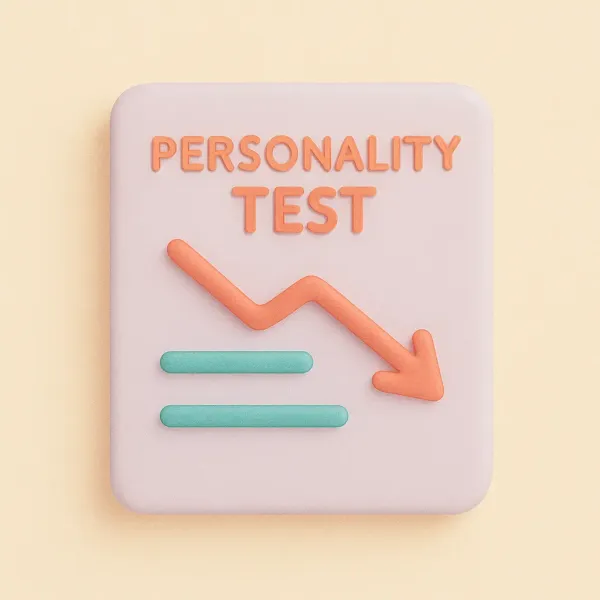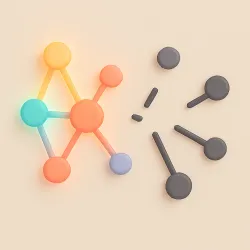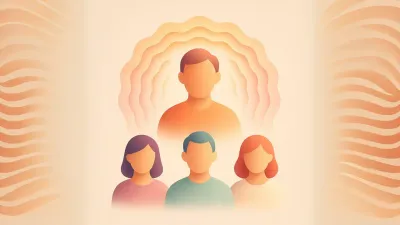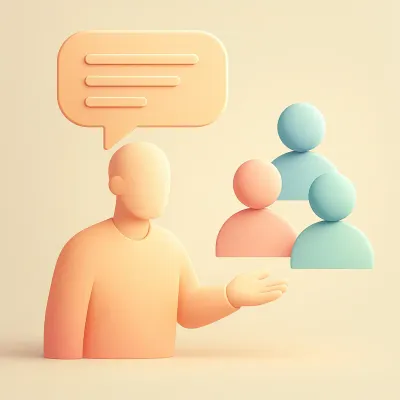A data-driven analysis of declining conscientiousness and rising neuroticism in the workplace, with evidence-based strategies for reversing these personality trends.
The Data That Should Stop Every Leader Cold
Young adults' conscientiousness has plummeted from 46 to 28 since 2014, while neuroticism has surged from 60 to 70, according to a Financial Times analysis of the Understanding America Study (Burn-Murdoch, 2025; based on Sutin et al., 2022). These aren't minor fluctuations. They represent a fundamental shift in how an entire generation approaches work, responsibility, and stress.
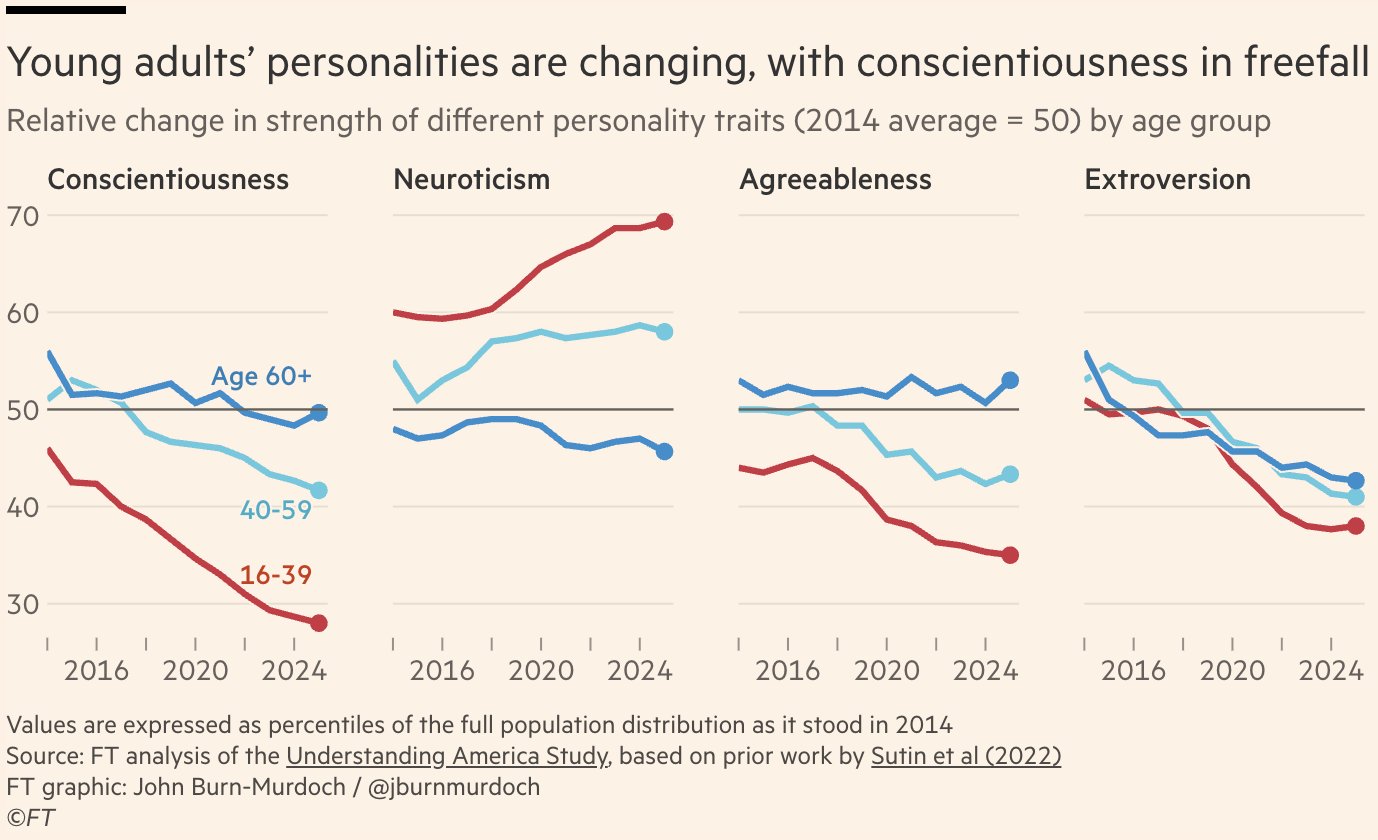
If you've noticed that managing teams feels different than it did a decade ago, that projects take longer to complete, or that workplace anxiety seems more pervasive, you're not imagining things. You're witnessing a personality shift that's reshaping the modern workplace.
Why Personality Matters More Than You Think
The Predictive Power of Personality
Personality traits aren't just psychological abstractions. They're powerful predictors of real-world outcomes. Roberts and colleagues (2007) demonstrated in their comprehensive review "The Power of Personality" that personality traits predict career success, relationship stability, and even mortality rates. What's particularly striking is that these traits often matter more than the factors we typically focus on, like socioeconomic background or cognitive abilities.
Conscientiousness stands out as particularly crucial for workplace success. Barrick and Mount's (1991) landmark meta-analysis found that conscientiousness predicts job performance across virtually all occupations, from entry-level positions to executive roles. It's the trait that determines whether someone follows through when things get difficult, chooses long-term success over short-term comfort, and maintains high standards even when no one is watching.
The Modern Context Makes This Even More Critical
In today's knowledge economy, the importance of conscientiousness has only intensified. As Cal Newport (2016) argues in "Deep Work," the ability to focus without distraction on cognitively demanding tasks has become increasingly rare and correspondingly valuable. Yet this is precisely the capability that's eroding.
The modern workplace is full of what behavioral scientists call "temptations" – from the dopamine hits of social media notifications to the instant gratification of AI-generated content. Mischel's famous marshmallow studies (Mischel et al., 1989) showed that the ability to delay gratification in childhood predicted success decades later. Now imagine that test, but instead of one marshmallow, there are thousands of digital marshmallows competing for attention every minute of every day.
What This Looks Like in Your Organization
The Conscientiousness Collapse
When conscientiousness drops, the changes are visible in everyday workplace behaviors:
Planning and Follow-Through Deteriorate Employees increasingly struggle to create realistic plans and stick to them. Research by Steel (2007) on procrastination shows that as conscientiousness decreases, the gap between intention and action widens. The team member who once submitted detailed project plans now operates in reactive mode, constantly putting out fires rather than preventing them.
Quality Standards Erode First drafts become final drafts. The careful review process that once caught errors gets skipped. Vohs and Baumeister (2016) found that self-control operates like a muscle that can be depleted, and in our high-distraction environment, that muscle is constantly exhausted.
Commitment Becomes Conditional Meetings scheduled weeks in advance get cancelled last minute. Deadlines become suggestions. The social contract that holds teams together – the mutual expectation that people will do what they say they'll do – begins to fray.
The Neuroticism Surge
Rising neuroticism creates its own set of challenges:
Emotional Contagion Spreads Stress Barsade's (2002) research on emotional contagion shows that emotions spread through organizations like viruses. When neuroticism is high, one person's anxiety can infect an entire team. A single stressed employee can shift the emotional tone of a meeting, turning productive discussion into defensive posturing.
Feedback Becomes Dangerous What used to be routine performance conversations now risk triggering disproportionate reactions. Managers report walking on eggshells, afraid that constructive criticism will lead to tears, anger, or resignation threats. This feedback avoidance creates a vicious cycle where problems go unaddressed until they become crises.
Trust Erodes High neuroticism correlates with lower interpersonal trust (Thielmann et al., 2020). Team members become more suspicious of each other's motives, more likely to assume negative intent, and less willing to be vulnerable. The psychological safety that Google's Project Aristotle identified as the foundation of high-performing teams becomes nearly impossible to maintain.
The Hidden Factor: Declining Agreeableness
While less dramatic than the other shifts, declining agreeableness (also documented in the Understanding America Study) undermines collaboration:
- The colleague who once stayed late to help others meet deadlines now leaves precisely at 5 PM
- Information hoarding replaces knowledge sharing
- "That's not my job" becomes a common refrain
- Team cohesion gives way to individual self-preservation
The Environmental Factors Driving These Changes
The Attention Economy's Assault on Conscientiousness
The timing of these personality shifts isn't coincidental. The steepest drops in conscientiousness align perfectly with the widespread adoption of smartphones and the proliferation of apps designed to capture and monetize attention. As former Google design ethicist Tristan Harris warns, we're experiencing "human downgrading" – the systematic erosion of our capacity for deep thought and sustained focus.
Research by Ward et al. (2017) found that the mere presence of a smartphone reduces cognitive capacity, even when the phone is turned off. Mark (2015) documented that after an interruption, it takes an average of 23 minutes to fully refocus on a task. In the modern workplace, those 23-minute blocks of deep focus have become nearly extinct.
The Remote Work Acceleration
The pandemic didn't create these personality shifts, but it accelerated them. Yang et al. (2022) analyzed communication patterns among 61,000 Microsoft employees and found that remote work led to more siloed networks, fewer weak ties, and less cross-team collaboration. The informal interactions that once built conscientiousness through social modeling and accountability disappeared overnight.
The AI Amplification Effect
Generative AI presents a new challenge that could dramatically widen the gap between high and low conscientiousness workers. As Brynjolfsson and McAfee (2014) predicted in "The Second Machine Age," technology doesn't just replace workers – it amplifies differences between them.
A conscientious employee uses AI as a cognitive partner, leveraging it to enhance their thinking and accelerate quality output. Their less conscientious peer uses the same tool to bypass learning entirely, generating passable work while developing no real expertise. The long-term implications are stark: those with high conscientiousness will become increasingly valuable, while those without it become increasingly replaceable.
The Organizational Response: Accommodation vs. Development
The Accommodation Trap
Most organizations, faced with these personality shifts, choose accommodation:
Lowering Standards Companies reduce performance expectations to avoid triggering stress. Deadlines become flexible. Quality standards get relaxed. The bar for "acceptable" work drops year after year.
Building Workarounds Instead of addressing root causes, organizations create elaborate support systems. They hire more project managers to compensate for employees who can't manage themselves. They implement surveillance software to monitor productivity rather than developing intrinsic motivation.
Accepting Decline Many leaders have resigned themselves to the idea that "this is just how young workers are now." They treat personality changes as immutable facts rather than malleable traits that respond to environmental factors.
Why Accommodation Fails
This approach is fundamentally flawed for several reasons:
- It Misunderstands Stress: Locke and Latham's (2002) goal-setting theory demonstrates that clear, challenging goals actually reduce anxiety by providing structure and building competence. When we remove all challenges, we remove the scaffolding that helps people grow.
- It Creates Learned Helplessness: Seligman's (1975) research on learned helplessness shows that when people believe they have no control over outcomes, they stop trying. By removing consequences for poor performance, we teach employees that their efforts don't matter.
- It Drives Away High Performers: Equity theory (Adams, 1963) predicts that when high performers see low performers receiving the same rewards, they either reduce their effort or leave. Accommodation strategies inevitably lead to talent drain.
The Evidence-Based Alternative: Environmental Design for Personality Development
The Malleability of Personality
The good news hidden in this data is that personality isn't fixed. The very fact that we've seen such dramatic shifts over the past decade proves that personality responds to environmental factors. Roberts et al. (2006) demonstrated that personality traits continue to change throughout adulthood, particularly in response to major life experiences and environmental changes.
Hudson and Roberts (2014) went further, showing that people can voluntarily change their personality traits when given the right tools and support. This isn't about surface-level behavior modification – it's about fundamental shifts in how people approach work and life.
Creating Conscientiousness-Building Environments
Organizations that want to reverse these trends need to be intentional about environmental design:
Protected Focus Time Newport's (2016) research on deep work shows that the ability to focus without distraction isn't just about willpower – it's about environmental design. Organizations should implement "focus blocks" where all meetings are forbidden, Slack is turned off, and deep work is not just allowed but expected.
At Happily.ai, we've seen teams that implement daily two-hour focus blocks report not just improved productivity, but also increased job satisfaction and reduced stress. The paradox is that by making work harder (requiring sustained focus), we make it more rewarding.
Visible Excellence Social learning theory (Bandura, 1977) demonstrates that people learn by observing others. When excellence is invisible, there's nothing to model. Organizations need to make high-quality work visible and specific. This isn't about generic praise but about detailed recognition of what makes work excellent.
Our data at Happily.ai shows that teams with regular, specific recognition have 23% higher engagement and 40% lower unwanted turnover. When people see exactly what good looks like and receive recognition for achieving it, conscientiousness becomes socially reinforced.
Completion Rituals The Zeigarnik effect (Zeigarnik, 1927) shows that uncompleted tasks create cognitive tension that impairs focus. Modern work, with its endless streams of tasks, never provides the satisfaction of completion. Organizations should create rituals around finishing work – documenting what was accomplished, what was learned, and why it mattered.
Structured Accountability Clear expectations and consistent follow-through rebuild conscientiousness. This means:
- Agendas required 24 hours before meetings
- Response time expectations for different communication channels
- Individual contributions tracked and visible
- Consequences for consistent underperformance
Building Resilience Against Neuroticism
Predictability Reduces Anxiety Research on uncertainty and anxiety (Grupe & Nitschke, 2013) shows that unpredictability is more stressful than difficult-but-predictable challenges. Organizations can reduce neuroticism by creating predictable rhythms: regular one-on-ones at the same time each week, consistent decision-making frameworks, clear escalation paths.
Cognitive Reframing Training Beck's cognitive therapy research (Beck, 1976) demonstrates that how we interpret events matters more than the events themselves. Organizations can teach cognitive reframing techniques, helping employees see challenges as opportunities for growth rather than threats to their competence.
Stress Inoculation Just as vaccines expose us to weakened versions of diseases to build immunity, organizations can build resilience through controlled exposure to manageable stressors. Meichenbaum's (1985) stress inoculation training shows that people who practice handling small stressors become better at handling large ones.
Measuring What Matters: The Happily.ai Approach
At Happily.ai, we've spent years developing systems that don't just measure these personality shifts but actively work to reverse them. Our approach is based on three principles:
1. Behavioral Measurement Over Self-Report
Instead of asking people if they're conscientious, we measure conscientiousness behaviors:
- Do they provide feedback regularly and thoughtfully?
- Do they recognize peers for work aligned with company values?
- Do they follow through on commitments?
- Do they engage in deep work or reactive task-switching?
Our Dynamic Engagement Behavior Index (DEBI) tracks these behaviors in real-time, giving managers visibility into personality-driven patterns before they become performance problems.
2. Environmental Nudges Over Mandates
We use behavioral science to make conscientious behaviors easier and more rewarding:
- Daily prompts for reflection that rebuild self-awareness
- Peer recognition systems that make excellence visible
- Focus time protection that makes deep work possible
- Progress visualization that provides completion satisfaction
Our data shows that teams using these nudges see a 37% improvement in conscientiousness-related behaviors within 90 days.
3. Development Over Diagnosis
Traditional personality assessments tell you what is. We focus on what could be. Our platform tracks not just current personality-driven behaviors but also their trajectory. Is conscientiousness improving or declining? Is neuroticism stabilizing or escalating? This forward-looking approach helps organizations intervene before personality shifts become performance crises.
The Path Forward: Your Next 90 Days
If you're ready to address these personality shifts in your organization, here's where to start:
Week 1-2: Baseline Assessment
- Survey your team on their biggest productivity obstacles
- Track meeting effectiveness and preparation levels
- Document quality standards and how often they're met
- Measure stress levels and their sources
Week 3-4: Environmental Design
- Implement daily two-hour focus blocks
- Create clear quality standards with examples
- Establish meeting hygiene rules (agendas, objectives, outcomes)
- Design completion rituals for major projects
Week 5-12: Consistent Implementation
- Protect the focus blocks religiously
- Recognize specific examples of excellent work weekly
- Address conscientiousness gaps directly but supportively
- Track behavioral changes, not just outcomes
Week 13: Measurement and Adjustment
- Compare conscientiousness behaviors to baseline
- Survey stress levels and job satisfaction
- Adjust interventions based on what's working
- Plan for sustainable long-term implementation
The Choice Every Organization Must Make
The data is clear: personality traits that predict workplace success are shifting in concerning directions. But this isn't a story of inevitable decline. It's a story of environmental influence and organizational choice.
Organizations can choose to accommodate these changes, lowering standards and accepting diminished performance as the new normal. Or they can choose to be intentional about creating environments that develop conscientiousness, reduce neuroticism, and rebuild the personality traits that enable both individual and organizational success.
The most successful organizations of the next decade won't be those with the best technology or the most innovative products. They'll be those that recognize personality as malleable and deliberately design environments that bring out the best in their people.
At Happily.ai, we're committed to helping organizations make this transition. Our platform provides the measurement, nudges, and insights needed to reverse these personality trends and build thriving, conscientious, resilient teams.
The question isn't whether these personality shifts are real – they are. The question isn't whether they matter – they do. The only question that matters is: What will your organization do about it?
Ready to measure and improve personality-driven behaviors in your organization? Learn how Happily.ai can help with our free organizational assessment and see where your team stands on conscientiousness, neuroticism, and other critical traits that drive performance.
Key Takeaways
- Young adult conscientiousness has dropped 40% since 2014, fundamentally changing workplace dynamics
- Personality traits predict job performance better than cognitive ability or background
- Most organizations wrongly accommodate these changes rather than reversing them
- Personality traits are malleable and respond to environmental design
- Specific interventions can rebuild conscientiousness within 90 days
References
Adams, J. S. (1963). Towards an understanding of inequity. Journal of Abnormal and Social Psychology, 67(5), 422-436.
Bandura, A. (1977). Social learning theory. Englewood Cliffs, NJ: Prentice Hall.
Barrick, M. R., & Mount, M. K. (1991). The Big Five personality dimensions and job performance: A meta-analysis. Personnel Psychology, 44(1), 1-26.
Barsade, S. G. (2002). The ripple effect: Emotional contagion and its influence on group behavior. Administrative Science Quarterly, 47(4), 644-675.
Beck, A. T. (1976). Cognitive therapy and the emotional disorders. New York: International Universities Press.
Brynjolfsson, E., & McAfee, A. (2014). The second machine age: Work, progress, and prosperity in a time of brilliant technologies. New York: W. W. Norton & Company.
Burn-Murdoch, J. (2025, January). Young adults' personalities are changing, with conscientiousness in freefall. Financial Times. Analysis based on Understanding America Study data.
Grupe, D. W., & Nitschke, J. B. (2013). Uncertainty and anticipation in anxiety: An integrated neurobiological and psychological perspective. Nature Reviews Neuroscience, 14(7), 488-501.
Hudson, N. W., & Roberts, B. W. (2014). Goals to change personality traits: Concurrent links between personality traits, daily behavior, and goals to change oneself. Journal of Research in Personality, 53, 68-83.
Locke, E. A., & Latham, G. P. (2002). Building a practically useful theory of goal setting and task motivation: A 35-year odyssey. American Psychologist, 57(9), 705-717.
Mark, G., Gudith, D., & Klocke, U. (2008). The cost of interrupted work: More speed and stress. Proceedings of the SIGCHI Conference on Human Factors in Computing Systems, 107-110.
Meichenbaum, D. (1985). Stress inoculation training. New York: Pergamon Press.
Mischel, W., Shoda, Y., & Rodriguez, M. L. (1989). Delay of gratification in children. Science, 244(4907), 933-938.
Newport, C. (2016). Deep work: Rules for focused success in a distracted world. New York: Grand Central Publishing.
Roberts, B. W., Kuncel, N. R., Shiner, R., Caspi, A., & Goldberg, L. R. (2007). The power of personality: The comparative validity of personality traits, socioeconomic status, and cognitive ability for predicting important life outcomes. Perspectives on Psychological Science, 2(4), 313-345.
Roberts, B. W., Walton, K. E., & Viechtbauer, W. (2006). Patterns of mean-level change in personality traits across the life course: A meta-analysis of longitudinal studies. Psychological Bulletin, 132(1), 1-25.
Seligman, M. E. P. (1975). Helplessness: On depression, development, and death. San Francisco: W. H. Freeman.
Steel, P. (2007). The nature of procrastination: A meta-analytic and theoretical review of quintessential self-regulatory failure. Psychological Bulletin, 133(1), 65-94.
Sutin, A. R., Luchetti, M., Aschwanden, D., Stephan, Y., & Terracciano, A. (2022). Differential personality change earlier and later in the coronavirus pandemic in a longitudinal sample of adults in the United States. PLOS ONE, 17(9), e0274542.
Thielmann, I., Spadaro, G., & Balliet, D. (2020). Personality and prosocial behavior: A theoretical framework and meta-analysis. Psychological Bulletin, 146(1), 30-90.
Vohs, K. D., & Baumeister, R. F. (Eds.). (2016). Handbook of self-regulation: Research, theory, and applications (3rd ed.). New York: Guilford Press.
Ward, A. F., Duke, K., Gneezy, A., & Bos, M. W. (2017). Brain drain: The mere presence of one's own smartphone reduces available cognitive capacity. Journal of the Association for Consumer Research, 2(2), 140-154.
Yang, L., Holtz, D., Jaffe, S., Suri, S., Sinha, S., Weston, J., ... & Teevan, J. (2022). The effects of remote work on collaboration among information workers. Nature Human Behaviour, 6(1), 43-54.
Zeigarnik, B. (1927). Das Behalten erledigter und unerledigter Handlungen. Psychologische Forschung, 9, 1-85.



